|
Scientific and Practical Journal of Modern Digital Technologiess №25, December 2025 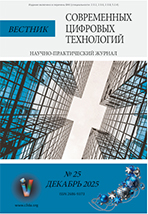
Scientific and Practical Journal of Modern Digital Technologiess №24, September 2025 
Scientific and Practical Journal of Modern Digital Technologiess №23, June 2025 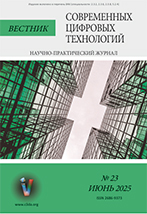
Scientific and Practical Journal of Modern Digital Technologiess №22, March 2025 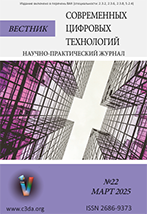
Scientific and Practical Journal of Modern Digital Technologiess №21, December 2024 
Scientific and Practical Journal of Modern Digital Technologiess №20, September 2024 
Scientific and Practical Journal of Modern Digital Technologiess №19, June 2024 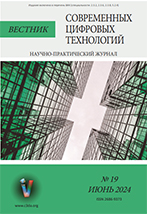
Scientific and Practical Journal of Modern Digital Technologiess №18, March 2024 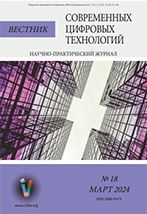
Scientific and Practical Journal of Modern Digital Technologiess №17, December 2023 
Scientific and Practical Journal of Modern Digital Technologiess №16, September 2023 
Scientific and Practical Journal of Modern Digital Technologiess №15, June 2023 
Scientific and Practical Journal of Modern Digital Technologiess №14, March 2023 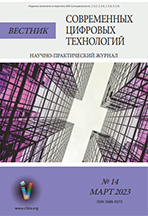
Scientific and Practical Journal of Modern Digital Technologiess №13, December 2022 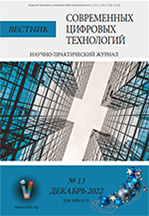
Scientific and Practical Journal of Modern Digital Technologiess №12, September 2022 
Scientific and Practical Journal of Modern Digital Technologiess №11, June 2022 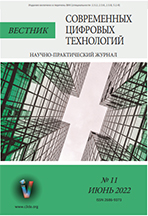
Scientific and Practical Journal of Modern Digital Technologiess №10, March 2022 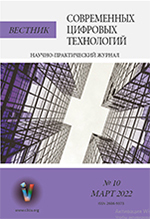
Scientific and Practical Journal of Modern Digital Technologiess № 9, December 2021 г. 
Scientific and Practical Journal of Modern Digital Technologiess № 8, September 2021 г. 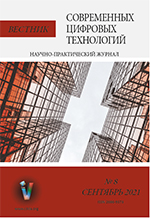
Scientific and Practical Journal of Modern Digital Technologiess № 7, june 2021 г. 
Scientific and Practical Journal of Modern Digital Technologiess № 6, march 2021 г. 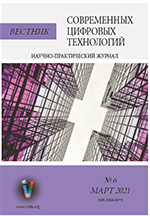
Scientific and Practical Journal of Modern Digital Technologiess № 5, December 2020 
Scientific and Practical Journal of Modern Digital Technologiess № 4, September 2020 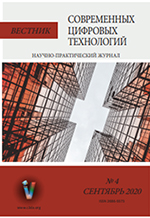
Scientific and Practical Journal of Modern Digital Technologiess № 3, May 2020 
Scientific and Practical Journal of Modern Digital Technologiess № 2, February 2020 
Scientific and Practical Journal of Modern Digital Technologiess № 1, October 2019 
|
☑ Scientific and Practical Journal ☑ Review process ☑ Editorial board ☑ Submission terms ☑ Abstracts and keywords to the articles |
|
|
SUBMISSION TERMS
The Journal publishes articles on general issues of digital economy, distributed ledgers, digital financial assets, cryptographic technologies, information security, digital technologies in education, finance and extractive industries, Internet of Things, digital art, literature on the digital economy, philosophical issues of digital technologies etc. Requirements for articles submitted for publication in the journal The article should contain new scientific results. It is allowed to publish articles devoted to a systematic review of current scientific research, containing original conclusions and judgments of the authors. The article must correspond with the subject and scientific level of the journal. Requirements to the content The article should be structured, i.e. should include parts with titles that concisely and accurately reflect their content, including: • an introduction containing a rationale for the relevance and a brief overview of the problem; • a clear statement of the research problem; • description of the method for solving the research problem; • interpretation and illustration of the research results obtained; • a summary, including generalization and indication of the application area of the obtained results, without repeating annotation and not limited to a simple listing of what was done in the work. Requirements for article formatting For publication in the journal, materials are accepted containing new results of scientific and practical research, corresponding with the profile of the journal, not previously published under identical names and not submitted to the editors of other journals. Only open source materials are accepted. The article should be accompanied by an explanatory (accompanying) letter from the author or organization. If necessary, the editors may request an expert opinion on the possibility of publication. The editors only accept for consideration manuscripts written in accordance to the rules. Articles must be provided in electronic and printed form (for example, scanned). The paper version of the article is signed by all authors, which means their consent to the transfer of rights to distribute the article materials using printed and electronic media. The number of authors in the article is no more than 7. Materials should include: • the text of the manuscript typed in MS Word and saved in doc or docx format; • UDC code (see UDC list) • title of the article (in Russian and/or English) • information about the authors: full name (fully in Russian and/or English), for each author - a footnote containing an academic title, position, organization name (without abbreviations), e-mail (in bold in the center); • An abstract describing the essence of the work and the results obtained (in Russian and/or English, at least 100 words or 5-7 lines); • keywords (in Russian and/or English, at least 100 characters or 8-10 words); • list of references. References in the text to literature are given in square brackets; • figure captions; • graphic material (graphs, tables, diagrams, figures, photographs, etc.) should be provided as separate files with a resolution of at least 300 pixels per inch in standard formats (TIFF, JPEG), text on figures - Times New Roman at least 10 pt. Tables should have thematic titles. The volume of articles, taking into account all points, except for graphic material, should not exceed 12-15 pages of A4 format, size 12, interval 1, margins 2 cm on all sides of the sheet, an approximate maximum of 30 thousand characters. The amount of graphic material - no more than 5 figures. References to graphic material and tables in the text are required. References and / or lists of referenced literature should be drawn up as following: 1. Hazay C., Lindell Y. Sigma protocols and efficient zero-knowledge // Efficient secure two-party protocols. Information security and cryptography. Springer, 2010. P. 147–175. 2. Fiat A., Shamir A. How To Prove Yourself: Practical Solutions to Identification and Signature Problems // Advances in Cryptology — CRYPTO' 86. Lecture Notes in Computer Science. Springer. Vol. 263. P. 186–194. 3. Bitansky N., Canetti R., Chiesa A., et al. From extractable collision resistance to succinct non-interactive arguments of knowledge, and back again // ITCS '12: Proceedings of the 3rd Innovations in Theoretical Computer Science Conference, January, 2012. P. 326–349. 4. Groth J., Sahai A. Efficient non-interactive proof systems for bilinear groups // SIAM Journal on Computing. Vol. 41(5). P. 1193-1232, 2012. 5. Wahby R., Tzialla I., Shelat A., et al. Doubly-Efficient zkSNARKs Without Trusted Setup // 2018 IEEE Symposium on Security and Privacy, San Francisco, 2018. P. 926-943. doi: 10.1109/SP.2018.00060. 6. Bunz B., Bootle J., Boneh D. et al. Bulletproofs: Short Proofs for Confidential Transactions and More // Proc. of IEEE Symposium on Security and Privacy, 2018. P. 315–334. 7. Ames S., Hazay C., Ishai Y. et al. Ligero: Lightweight Sublinear Arguments Without a Trusted Setup // Proceedings of the 24th ACM Conference on Computer and Communications Security. CCS ’17. 2017. P. 2087–2104. |
||

